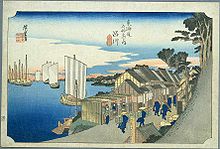Shinagawa-juku
Contenu soumis à la licence CC-BY-SA. Source : Article Shinagawa-juku de Wikipédia en français (auteurs)
Regardez d'autres dictionnaires:
Shinagawa-juku — nihongo|Shinagawa shuku|品川宿|Shinagawa shuku was the first of the fifty three stations of the Tōkaidō. [http://japan city.com/sina/ Tōkaidō Shinagawa juku] . Haguregumo. Accessed December 10, 2007.] It is presently located in Shinagawa, Tokyo,… … Wikipedia
Hirakata-juku — and traces of the post town can still be seen today.HistoryHirakata was formed in 1596, under the order of Toyotomi Hideyoshi. Though initially developed for other purposes, it became a post town when Tokugawa Ieyasu extended the Tōkaidō with the … Wikipedia
Kawasaki-juku — dans les années 1830, estampe d Hiroshige dans l édition Hoeido de Les Cinquante trois Stations du Tōkaidō (1831 1834) Kawasaki juku (川崎宿, Kawasaki shuku … Wikipédia en Français
Kawasaki-juku — nihongo|Kawasaki juku|川崎宿|Kawasaki shuku was the second of the fifty three stations of the Tōkaidō. It is located in Kawasaki ku in the present day city of Kawasaki, Kanagawa Prefecture, Japan.HistoryKawasaki juku was established as a post… … Wikipedia
Miya-juku — in the 1830s, as depicted by Hiroshige in The Fifty three Stations of the Tōkaidō Miya juku (宮宿, Miya juku … Wikipedia
Ōtsu-juku — Hiroshige s print of Ōtsu juku, part of the The Sixty nine Stations of the Kiso Kaidō series … Wikipedia
Mariko-juku — in the 1830s, as depicted by Hiroshige in The Fifty three Stations of the Tōkaidō Mariko juku (鞠子宿, Mariko juku … Wikipedia
Okabe-juku — in the 1830s, as depicted by Hiroshige in The Fifty three Stations of the Tōkaidō Okabe juku (岡部宿, Okabe juku … Wikipedia
Mitsuke-juku — in the 1830s, as depicted by Hiroshige in The Fifty three Stations of the Tōkaidō Mitsuke juku (見附宿, Mitsuke juku … Wikipedia
Maisaka-juku — in the 1830s, as depicted by Hiroshige in The Fifty three Stations of the Tōkaidō Maisaka juku (舞阪宿, Maisaka juku … Wikipedia
 Shinagawa-juku dans les années 1830, estampe d'Hiroshige de la série Les Cinquante-trois Stations du Tōkaidō
Shinagawa-juku dans les années 1830, estampe d'Hiroshige de la série Les Cinquante-trois Stations du Tōkaidō
